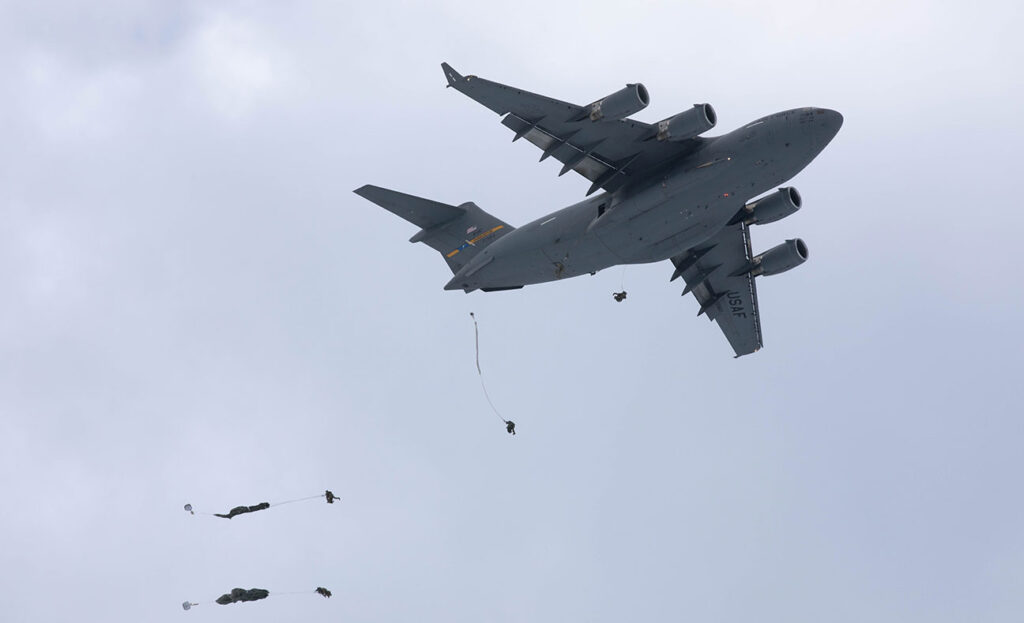Paratroopers from the 82nd Airborne Division jump from a C-17 Globemaster III during an integrated joint forcible entry exercise for Swift Response 25 in May. SGT. DEVYN ADAMS/U.S. ARMY
THE WATCH STAFF
United States troops joined forces with 29 allied and partner nations in May 2025 to undertake Defender 25, a large-scale, three-phase exercise led by the U.S. European Command (USEUCOM) designed to stress test NATO responses to potential external threats. Tens of thousands of troops are scheduled to participate in the exercise, which lasts into June.
“DEFENDER 25 increases the lethality of the NATO alliance through large-scale tactical training maneuvers and long-range fires, builds unit readiness in a complex joint, multinational environment and leverages host nation capabilities to increase the U.S. Army’s operational reach,” stated a U.S. Army Europe and Africa news release.
The first phase, Swift Response, which began in May, involved coordinated paratroop drops in the Nordic region and transporting troops and equipment to Scandinavia from the United Kingdom. It kicked off with U.S. Army 82nd Airborne Division Paratroopers conducting a jump into Norway. Nearly simultaneously, NATO allies executed jumps in Finland, Latvia and Lithuania. The drills also included troop movements from the U.K. to Norway and Sweden, according to the High North News, a Norwegian newspaper.
Another paratroop jump in Lithuania involved more than 1,600 paratroopers from France, Germany, Italy, the Netherlands and U.S. in a major airborne assault exercise led by the U.S. Army’s 173rd Airborne Brigade “Sky Soldiers” near Pabrade, a town northeast of the capital, Vilnius, which has a large military training area near the border with Belarus. “Leading this multinational airborne assault is an honor and a responsibility our Sky Soldiers take seriously,” said Col. Joshua Gaspard, commander, 173rd Airborne Brigade, in an Army news release. “With five Allies on this drop zone, Swift Response 25 gives us the chance to demonstrate that we can move fast, fight hard, and be ready — together.”
The 173rd Airborne Brigade will also pioneer a new capability: delivering blood to the battlefield with drones. “This exercise lets us stress-test our medical systems in the most realistic conditions possible,” said Maj. David Hourani, brigade surgeon, 173rd Airborne Brigade.
Defender 25 is the largest U.S. Army exercise in Europe. Last year, 17,000 U.S. troops joined 23,000 NATO troops during Operation Steadfast Defender, the largest NATO exercise since the Cold War. This year, about 5,000 U.S.-based troops have deployed to participate. Nearly 30,000 military personnel from more than two dozen nations are slated to take part over the exercise’s three phases, which are designed to counter specific regional and situational threats. Swift Response’s near-simultaneous jumps demonstrate the alliance’s quick-response deployment to an incursion in the Baltic and Nordic regions. That phase, which ran May 11 through May 31, involved 6,000 U.S. and allied troops, according to a U.S. Army Europe and Africa fact sheet.
The second phase — Immediate Response — runs from May 26 to June 11 in southeastern Europe and will feature a joint mechanized brigade attack showcasing infantry modernization and capabilities. Advances in equipment capabilities and coordinated response efforts will be showcased during a joint training event involving a simulated chemical attack and response at port facilities. Live fire exercises and training will take place in Albania, Bosnia and Herzegovina, Bulgaria, Croatia, Greece, Hungary, Kosovo, Montenegro and North Macedonia, according to the command. In all, 12,000 troops from the U.S. and 19 allied nations will participate.
The final phase — Saber Guardian — stretches from June 9 through June 24 and includes about 10,000 troops from the U.S. and six partner nations. Saber Guardian will feature a fire support coordination exercise in Hungary to demonstrate the capability to coordinate artillery fire on designated targets identified by aerial assets. Two water crossings in Romania will also test the alliance’s logistical capabilities to move troops and equipment quickly through challenging terrain.

